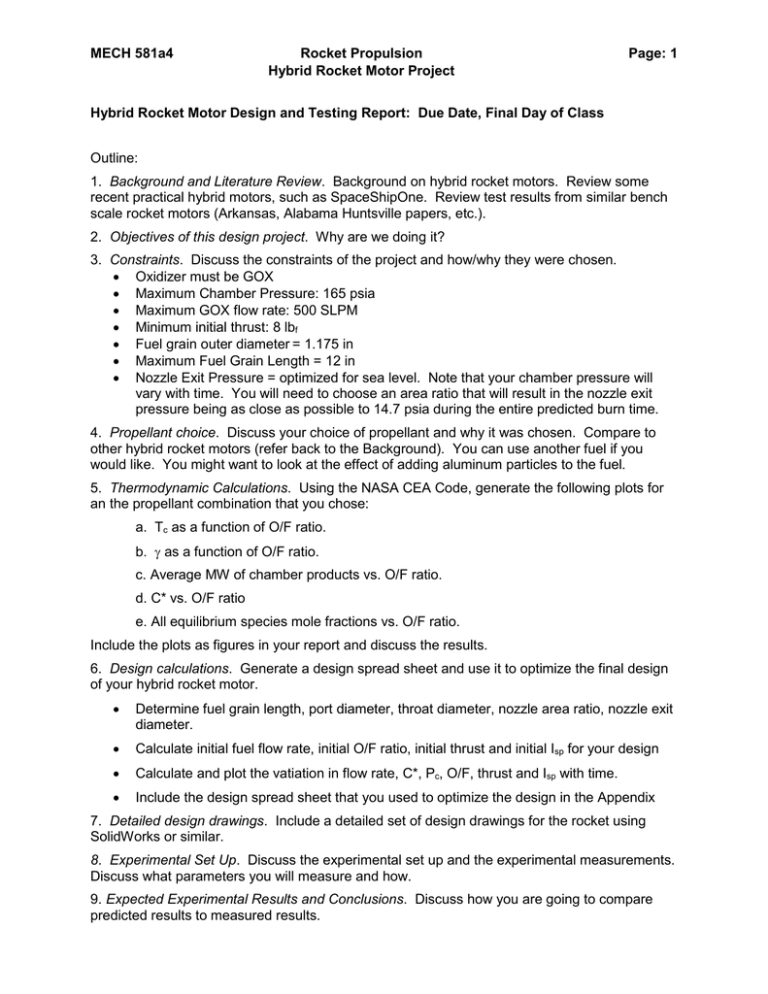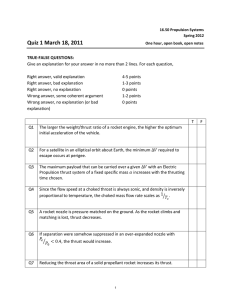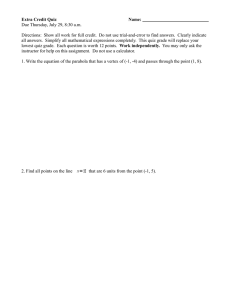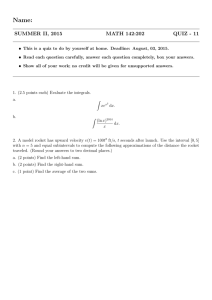MECH 581a4 Rocket Propulsion Page: 1
advertisement

MECH 581a4 Rocket Propulsion Hybrid Rocket Motor Project Page: 1 Hybrid Rocket Motor Design and Testing Report: Due Date, Final Day of Class Outline: 1. Background and Literature Review. Background on hybrid rocket motors. Review some recent practical hybrid motors, such as SpaceShipOne. Review test results from similar bench scale rocket motors (Arkansas, Alabama Huntsville papers, etc.). 2. Objectives of this design project. Why are we doing it? 3. Constraints. Discuss the constraints of the project and how/why they were chosen. Oxidizer must be GOX Maximum Chamber Pressure: 165 psia Maximum GOX flow rate: 500 SLPM Minimum initial thrust: 8 lbf Fuel grain outer diameter = 1.175 in Maximum Fuel Grain Length = 12 in Nozzle Exit Pressure = optimized for sea level. Note that your chamber pressure will vary with time. You will need to choose an area ratio that will result in the nozzle exit pressure being as close as possible to 14.7 psia during the entire predicted burn time. 4. Propellant choice. Discuss your choice of propellant and why it was chosen. Compare to other hybrid rocket motors (refer back to the Background). You can use another fuel if you would like. You might want to look at the effect of adding aluminum particles to the fuel. 5. Thermodynamic Calculations. Using the NASA CEA Code, generate the following plots for an the propellant combination that you chose: a. Tc as a function of O/F ratio. b. as a function of O/F ratio. c. Average MW of chamber products vs. O/F ratio. d. C* vs. O/F ratio e. All equilibrium species mole fractions vs. O/F ratio. Include the plots as figures in your report and discuss the results. 6. Design calculations. Generate a design spread sheet and use it to optimize the final design of your hybrid rocket motor. Determine fuel grain length, port diameter, throat diameter, nozzle area ratio, nozzle exit diameter. Calculate initial fuel flow rate, initial O/F ratio, initial thrust and initial Isp for your design Calculate and plot the vatiation in flow rate, C*, Pc, O/F, thrust and Isp with time. Include the design spread sheet that you used to optimize the design in the Appendix 7. Detailed design drawings. Include a detailed set of design drawings for the rocket using SolidWorks or similar. 8. Experimental Set Up. Discuss the experimental set up and the experimental measurements. Discuss what parameters you will measure and how. 9. Expected Experimental Results and Conclusions. Discuss how you are going to compare predicted results to measured results. MECH 581a4 Rocket Propulsion Hybrid Rocket Motor Project Page: 2 10. Experimental Results The hybrid rocket motor test stand enabled the measurement of the following parameters: Instantaneous chamber pressure, Pc(t) [psig] ox ( t ) [SLPM] Instantaneous oxygen mass flow rate, m Instantaneous Thrust, F [lbf] Total mass of fuel consumed, Mf (by weighing the fuel before and after combustion) Make plots of instantaneous flow rate, thrust and chamber pressure and qualitatively discuss the results. Describe the test itself (see video if you forget what it looked or sounded like). Did the rocket perform as expected? If not, why? Include photographs of your rocket test if you took any. 11. Comparison of Experimental Results with Original Model a. Re-plot the measured thrust vs. time and Pc vs. time, along with your original model predictions, which assumed a constant oxidizer mass flow rate (of 500 SLPM or whatever you assumed). Comment on agreement or disagreement of your model with respect to the experimental results. Other than the initial transient, does the thrust and chamber pressure vary with time as predicted by your model. If not, why? Discuss. b. Make a plot of measured thrust coefficient vs. time and compare to your team’s predicted plot of thrust coefficient vs. time. Comment on agreement or disagreement of your model with respect to the experimental results. Other than the initial transient, does the thrust coefficient vary with time as predicted by your model. If not, why? Discuss. c. Given the results of part b, calculate the overall thrust coefficient efficiency using the following equation: CF 1 b CF,exp dt b o 1 b CF,th dt b o Comment on the results. For a discussion on the departure from ideal conditions in a nozzle, see notes09.doc. d. Calculate total impulse for your rocket using the following equation: b I Fdt 0 And compare this value to the predicted total impulse. e. Calculate the measured specific impulse of your rocket motor using the following equation: b ISP Fdt 0 goMP b Fdt 0 b ox dt ) go (Mf m o Compare the measured specific impulse with the predicted specific impulse. MECH 581a4 Rocket Propulsion Hybrid Rocket Motor Project Page: 3 f. Calculate average C* for your rocket motor using the following equation. At * Cexp 1 b Pc dt b 0 Mf 1 b m ox dt b b o Compare this value with the average predicted C* from your model. Comment on the results. g. Calculate the average C* efficiency for your rocket motor. C* * Cexp Cth* Comment on the results. As discussed in your notes, this value is typically expected to be greater than 95%. 12. Refined Theoretical Model Using the actual instantaneous oxidizer mass flow rate, redevelop your spreadsheet and recalculate the predicted variation in C*, Pc, O/F, thrust and Isp with time. a. Re-plot the measured thrust vs. time and Pc vs. time, along with your refined model predictions, which takes into account the actual variation in delivered oxidizer flow rate with time. Comment on agreement of your model with respect to the experimental results. Does the thrust and chamber pressure vary with time as predicted by your model. Now that you are taking into account the initial transient period in the oxidizer flow rate, does the model compare better with experiments. If not, why? Discuss. b. Compare the new predicted values of total impulse, specific impulse, C*, and CF with the experimental results. Discuss whether the refined model predicts these parameters better than the original model. 13. Conclusions and Recommendations Comment on the overall design project. Discuss whether or not the design project was effective in providing practical experience to reinforce the theoretical aspects of the course. Provide recommendations for improving the project in the future.






